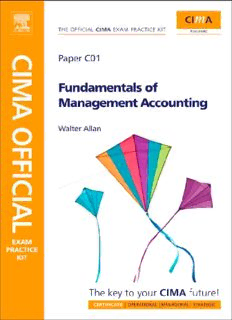
CIMA Official Exam Practice Kit Fundamentals of Management Accounting, Third Edition: CIMA Certificate in Business Accounting PDF
Preview CIMA Official Exam Practice Kit Fundamentals of Management Accounting, Third Edition: CIMA Certificate in Business Accounting
This page intentionally left blank CIMA Exam Practice Kit CIMA Certificate in Business Accounting Fundamentals of Management Accounting Walter Allan Amsterdam•Boston• Heidelberg• London• New York• Oxford Paris• San Diego• San Francisco• Singapore• Sydney• Tokyo CIMAPublishing is an imprint of Elsevier The Boulevard, Langford Lane, Kidlington, Oxford, OX5 1GB, UK 30 Corporate Drive, Suite 400, Burlington, MA01803, USA First edition 2008 Copyright © 2010 Elsevier Ltd. All rights reserved No part of this publication may be reproduced, stored in a retrieval system or transmitted in any form or by any means electronic, mechanical, photocopying, recording or otherwise without the prior written permission of the publisher Permissions may be sought directly from Elsevier’s Science and Technology Rights Department in Oxford, UK: phone: ((cid:2)44)(0) 1865 843830; fax: ((cid:2)44)(0) 1865 853333; e-mail: [email protected]. Alternatively you can submit your request online by visiting the Elsevier web site at http://elsevier.com/locate/permissions, and selecting Obtaining permission to use Elsevier material Notice No responsibility is assumed by the publisher for any injury and/or damage to persons or property as a matter of products liability, negligence or otherwise, or from any use or operation of any methods, products, instructions or ideas contained in the material herein. British Library Cataloguing in Publication Data Acatalogue record for this book is available from the British Library ISBN: 978-1-85617-778-8 For information on all CIMAPublishing visit our web site at www.books.elsevier.com Printed and bound in Great Britain 10 11 12 10 9 8 7 6 5 4 3 2 1 This page intentionally left blank Contents About the Author viii Syllabus Guidance, Learning Objectives and Verbs ix Examination Techniques xvii 1 Cost Behaviour 1 Concepts and definitions questions 3 Concepts and definitions solutions 5 Multiple choice questions 7 Multiple choice solutions 9 2 Accounting for the Value of Inventories 11 Concepts and definitions questions 13 Concepts and definitions solutions 14 Multiple choice questions 16 Multiple choice solutions 18 3 Overhead Costs: Allocation, Apportionment and Absorption 21 Concepts and definitions questions 23 Concepts and definitions solutions 25 Multiple choice questions 27 Multiple choice solutions 29 4 Cost–Volume–Profit Analysis 31 Concepts and definitions questions 33 Concepts and definitions solutions 35 Multiple choice questions 37 Multiple choice solutions 40 5 Standard Costs 43 Concepts and definitions questions 45 Concepts and definitions solutions 47 Multiple choice questions 49 Multiple choice solutions 51 v vi Contents 6 Variance Analysis 53 Concepts and definitions questions 55 Concepts and definitions solutions 57 Multiple choice questions 59 Multiple choice solutions 61 7 Cost Book-keeping 63 Concepts and definitions questions 65 Concepts and definitions solutions 68 Multiple choice questions 73 Multiple choice solutions 76 8 Job and Batch Costing 79 Concepts and definitions questions 81 Concepts and definitions solutions 83 Multiple choice questions 85 Multiple choice solutions 88 9 Contract Costing 91 Concepts and definitions questions 93 Concepts and definitions solutions 95 Multiple choice questions 98 Multiple choice solutions 100 10 Process Costing 103 Concepts and definitions questions 105 Concepts and definitions solutions 107 Multiple choice questions 110 Multiple choice solutions 113 11 Managerial Reports in a Service Organisation 117 Concepts and definitions questions 119 Concepts and definitions solutions 121 Multiple choice questions 123 Multiple choice solutions 126 12 Functional Budgets 129 Concepts and definitions questions 131 Concepts and definitions solutions 133 Multiple choice questions 135 Multiple choice solutions 137 13 Cash Budgets 139 Concepts and definitions questions 141 Concepts and definitions solutions 143 Multiple choice questions 145 Multiple choice solutions 148 Contents vii 14 Flexible Budgets 151 Concepts and definitions questions 153 Concepts and definitions solutions 154 Multiple choice questions 155 Multiple choice solutions 157 Mock Assessments 1, 2 and 3 159 vii About the Author Walter Allan has lectured, written, examined and published in the fields of Management andAccounting for the past 25 years. He has lectured on CIMAcourses for a number of UK private colleges and is a former CIMAexaminer. He is chief executive of Galashiels Economic Consultancy, a company which specialises in professional Accountancy training. viii Syllabus Guidance, Learning Objectives and Verbs A The Certificate in Business Accounting The Certificate introduces you to management accounting and gives you the basics of accounting and business. There are five subject areas, which are all tested by computer- based assessment (CBA). The five papers are: • Fundamentals of Management Accounting • Fundamentals of Financial Accounting • Fundamentals of Business Mathematics • Fundamentals of Business Economics • Fundamentals of Ethics, Corporate Governance and Business Law The Certificate is both a qualification in its own right and an entry route to the next stage in CIMA’s examination structure. The examination structure after the Certificate comprises: • Managerial Level • Strategic Level • Test of Professional Competence in Management Accounting (an exam based on a case study). This examination structure includes more advanced papers in Management Accounting. It is therefore very important that you work hard at Fundamentals of Management Accounting, not only because it is part of the Certificate, but also as a platform for more advanced studies. It is thus an important step in becoming a qualified member of the Chartered Institute of Management Accountants. B Aims of the syllabus The aims of the syllabus are • to provide for the Institute, together with the practical experience requirements, an adequate basis for assuring society that those admitted to membership are competent to act as management accountants for entities, whether in manufacturing, commercial or service organisations, in the public or private sectors of the economy; ix
